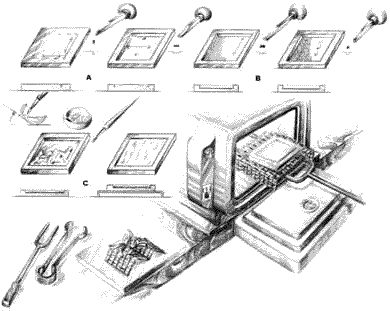|
The enamel is contained in a metal border obtained with an excavation or with an applique', its thickness mustn't be above half a millimeter, for the reason that with a higher layer of enamel it could crack. The bottom part can have designs, motives and cut effects that besides giving a greater capacity to the enamel, if this is transparent, will be visible and will increase the colour of the enamel of vivacity (dis. B). Before receiving the enamel, the oxid, the fat and the powder have to be cleaned off the metal object. The enamel will be deposited with different brushes for every colour used, so that there is no risk of contamining the powders with the other dyes. A good quality of enamel generally provides two to four phases of enamelling and cooking of the colour, with very thin layers and placed one upon the other. Once the enamel has been put on the object (it mustn't be too wet nor too dry, it mustn't have formed grains and it mustn't slide), check that any enamel has come out of the design; at this point lay it all on a steel grill that keeps the object slightly lifted from the base that is inside the oven
|
|
|
|
|
|
so that it is heated uniformly and then it can be removed (dis. C). The best temperature of the oven is about 1000 C° degrees; once this temperature is reached, open the oven and let the object cool down and let the remained water evaporate; this operation will avoid the detachment of the enamel due to a continuous introdution of the object. Not even after a minute the enamel that has been cooked, will have the aspect of a lemon peel; take the object out and let it cool down slowly, take the oxidization off with a little brush of glass and rinse it in a abundant way; if it's the case proceed with a bath of decoating. Repeat the operation of enamelling for the other layers. The last cooking will have to be brought to a temperature way over the lemon peel effect so that the result is a uniformly smooth surface. Once it has been enamelled, the object can be levigated with a pumice-stone and running water and then rinsed. Once it's dry it will have to be cooked again. If it's the case repeat the operation with more fine and polishing abrasives.
|
|
